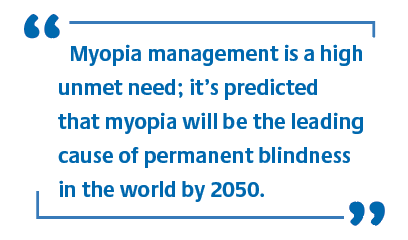 |
Finding a “subspecialty” in optometry can enhance your practice life. One big area of focus right now, but in ample need of more doctors, is myopia management. Let’s take a look at how you can make it a successful part of your practice.
Why Get Involved?
Myopia management is a high unmet need; it’s predicted that myopia will be the leading cause of permanent blindness in the world by 2050. In the United States alone, over 42% of the population between ages five and 19 is myopic, a number that continues to increase as people spend more time on digital devices and less time outdoors.1
Many parents believe that reducing their children’s myopia will simply allow them to wear thinner glasses. But, when they’re informed that the primary purpose of intervention is to prevent diseases caused by axial length growth, such as a ninefold greater risk of retinal detachment and a 3.3-times greater risk of glaucoma and cataracts, there is often instant motivation for pursuing options for treatment.2-4 You can help children avoid such conditions in the future by managing their myopia now.
Ideal Candidates
An objective approach to finding ideal candidates for myopia intervention is through cycloplegic refraction. The following indicates a significant risk of high myopia development:5
- age six: refraction of +0.75D or less
- ages seven and eight: any refraction of +0.50D or less
- ages nine and 10: anything less than or equal to +0.25D
- age 11: at plano or myopic
A Simple Approach
To get started, have a way to monitor progression via refraction and axial length measurements, as well as treatment options. For monitoring, I suggest starting with refraction alone, and as your practice expands, consider investing in axial length devices ranging from ultrasounds (DGH Technology) to highly repeatable, precise devices that don’t touch the eye, such as the Lenstar (Haag-Streit). There are also advanced devices such as the Myopia Master (Oculus) with multiple useful features including corneal curvature, risk calculators, pupil measurement and axial length.
 |
Regarding treatments, offer a range of options that project myopic defocus onto the peripheral retina. This could include contact lenses (MiSight) and/or ortho-K lenses, spectacles (Stellest) and atropine drops. Know the concentration of atropine drops and find an established, reliable compounding pharmacy such as ImprimisRx, Ocular Science or Primera. A child that is too young for contact lens wear would benefit from atropine drops while a moderate-to-low myope who is older could benefit from ortho-K lenses.
Environmental Suggestions
While we need treatments to slow myopia progression, we must also recommend evidence-based solutions. For example, children who are outdoors for 1.5 hours per day or 11 hours per week experience 54% less myopia progression. Near work increases progression, so recommending that myopes limit their digital device use may have multiple benefits.6 Much of this information can be provided through patient education materials.
Expected Progression
A myopic Caucasian child is expected to progress by 0.55D per year; anything less is considered to be a success, but rates do vary based on ethnicity and gender. For example, Asian children progress at 0.82D per year and females progress slightly more than males per year at 0.09D. Most children stabilize around age 16, although mild progression beyond this time is possible.
Myopia management has real benefits and a significant patient population in need of slowing the progression from blinding complications. Depending on your practice setting and what motivates you, this area of expertise may be worth considering.
Dr. Karpecki is medical director for Keplr Vision and the Dry Eye Institutes of Kentucky and Indiana. He is the Chief Clinical Editor for Review of Optometry and chair of the New Technologies & Treatments conferences. A fixture in optometric clinical education, he consults for a wide array of ophthalmic clients, including ones discussed in this article. Dr. Karpecki's full list of disclosures can be found here.
1. Theophanous C, Modjtahedi BS, Batech M, et al. Myopia prevalence and risk factors in children. Clin Ophthalmol. 2018;12:1581-7. 2. Ogawa A, Tanaka M. The relationship between refractive errors and retinal detachment - analysis of 1,166 retinal detachment cases. Jpn J Ophthalmol. 1988;32(3):310-5. 3. Lim R, Mitchell P, Cumming RG. Refractive associations with cataract: the Blue Mountains Eye Study. Invest Ophthalmol Vis Sci. 1999;40(12):3021-6. 4. Nguyen CQ, Peck AB. Unraveling the pathophysiology of Sjogren syndrome-associated dry eye disease. Ocul Surf. 2009;7(1):11-27. 5. Truong S, Cole N, Stapleton F, Golebiowski B. Sex hormones and the dry eye. Clin Exp Optom. 2014;97(4):324-36. 6. De Martinis M, Franceschi C, Monti D, Ginaldi L. Inflamm-ageing and lifelong antigenic load as major determinants of aging rate and longevity. FEBS Lett. 2005;579(10):2035-9. |

